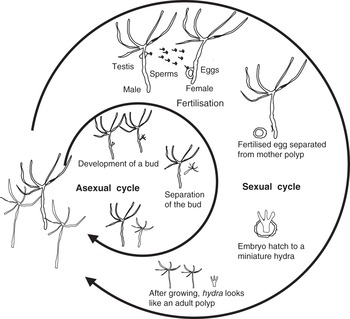CNIDARIANS AND CTENOPHORA
1/34
There's no tags or description
Looks like no tags are added yet.
Name | Mastery | Learn | Test | Matching | Spaced |
|---|
No study sessions yet.
35 Terms
Diploblastic
(two germ layers: ectoderm and endoderm, with mesoglea in between).
polyp
-Sessile (attached) form (e.g., Hydra, sea anemone).
Free-swimming, bell-shaped form (e.g., jellyfish).
Medusa
Cnidocytes and Nematocysts
Specialized stinging cells used for defense and capturing prey.
Incomplete digestive system
single opening functions as both mouth and anus
Nervous system Cnidarians and Ctenophora
Simple nerve net, no centralized brain
Asexual
budding
Parent Hydra forms a bud → Bud develops tentacles and mouth → Detaches and becomes independent.
sexual
gamete formation
Gametogenesis & Fertilization)
Testes produce sperm & ovaries produce eggs → Fertilization occurs → Zygote forms.
Phylum ctenophora
commonly referred to as comb jellies, encompasses a group of marine invertebrates known for their distinctive, jelly-like appearance and unique locomotive mechanisms.
These creatures, often mistaken for jellyfish, play a significant role in marine ecosystems across the globe.
Comb plates
biradial symmetry and are equipped with eight rows of cilia, known as
which facilitate swimming and prey capture
Collablast
sticky cells on their tentacles, to ensnare their prey, which mainly includes small crustaceans, fish eggs, and other marine invertebrates.
Nematocyst
a specialized cell in the tentacles of a jellyfish or other coelenterate, containing a barbed or venomous coiled thread that can be projected in self-defense or to capture prey.
Bioluminescence
A notable feature of many ctenophore species is their ability to produce light bioluminescence, adding a mystical aspect to their presence in the ocean waters

stomodaeum
the large, expandable gastric cavity that opens from the mouth, also known as the pharynx, and is a key part of their digestive system
aboral anal pores
refers to a pair of small pores located at the aboral (opposite the mouth) end of the animal, through which waste products are expelled from the branched endodermal canal system
Colloblast
specialized, adhesive cells found in the tentacles of ctenophores (comb jellies) used to capture prey
statocyst
a key sensory organ located at the aboral pole (opposite the mouth) that functions as a balance and orientation sensor, containing a statolith and balancers to detect gravity and movement
hermaphroditic
an organism possessing both male and female reproductive organs, or exhibiting both male and female characteristics
cydippid larva stage.
a free-swimming, larval stage of ctenophores (comb jellies) that closely resembles the adult, particularly those belonging to the order _______ and are known for their direct development and early reproduction
Predators of Zooplankton
Regulate populations of small marine organisms.
Bioluminescence
Studied for biomedical applications.
Marine Biodiversity
Contribute to oceanic food chains
Invasive Species Concern
Some ctenophores (e.g., Mnemiopsis leidyi) disrupt fish populations in non-native waters
Sexual Reproduction of Coral Anemone life cycle
Gamete release → Fertilization → Planula larva → Settlement → New polyp formation.
Asexual Reproduction of Coral Anemone life cycle
Budding → New polyps form coral colonies.
Fragmentation → Broken pieces regenerate into new individuals.
Pedal Laceration (Sea anemones) → Small tissue pieces develop into new anemones.
Asexual Reproduction pf Hydra (BUDDING)
Parent Hydra forms a bud → Bud develops tentacles and mouth → Detaches and becomes independent.
example: Hydra viridissima (green hydra) and Hydra oligactis (brown hydra)

Sexual Reproduction of Hydra (Gametogenesis and Fertilization)
Testes produce sperm & ovaries produce eggs → Fertilization occurs → Zygote forms.
Example: Hydra circumcincta

Planula Larva Stage
Zygote develops into a planula → Planula settles → New Hydra forms